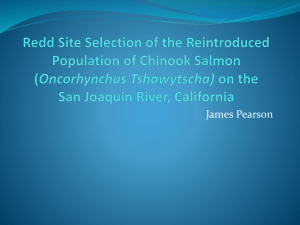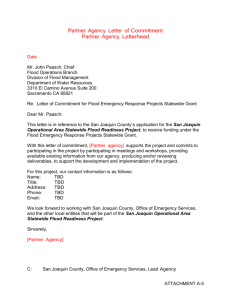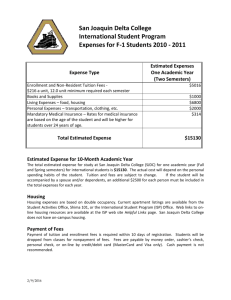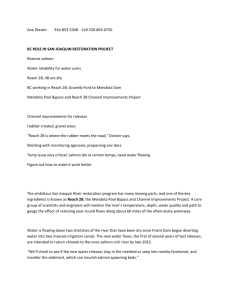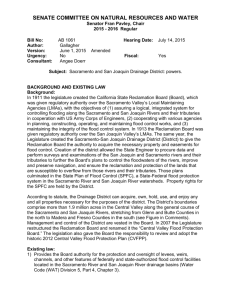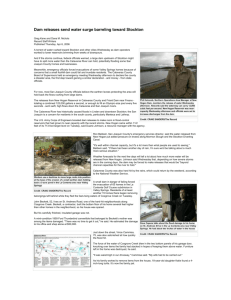Bill Luce, History of the River
advertisement
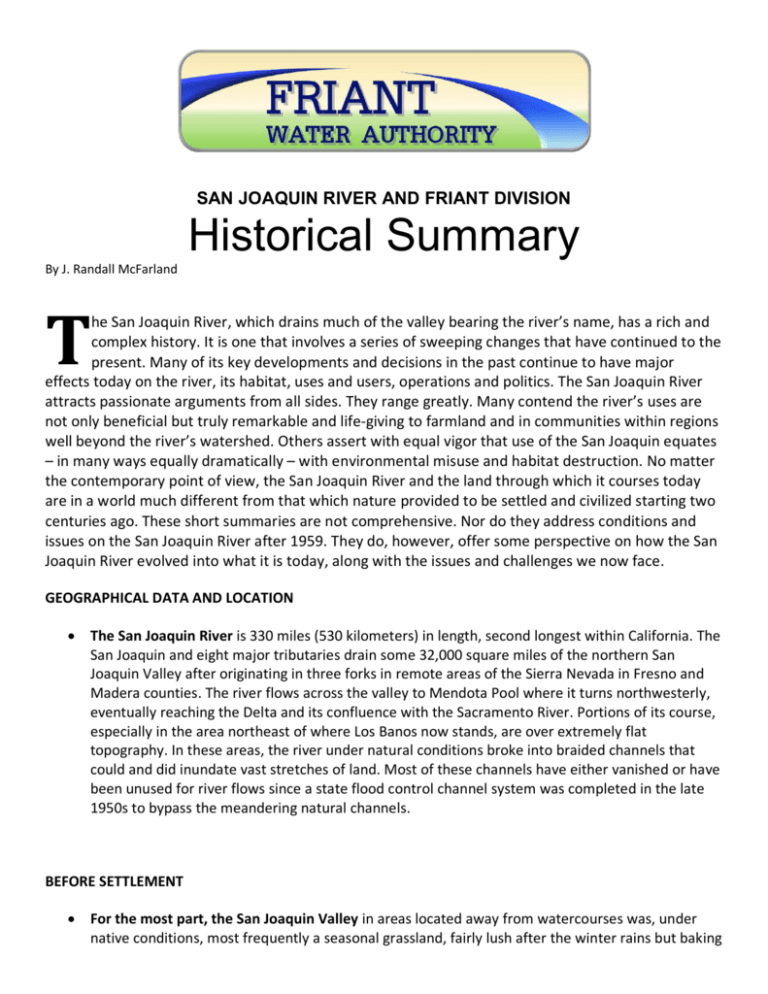
SAN JOAQUIN RIVER AND FRIANT DIVISION Historical Summary By J. Randall McFarland T he San Joaquin River, which drains much of the valley bearing the river’s name, has a rich and complex history. It is one that involves a series of sweeping changes that have continued to the present. Many of its key developments and decisions in the past continue to have major effects today on the river, its habitat, uses and users, operations and politics. The San Joaquin River attracts passionate arguments from all sides. They range greatly. Many contend the river’s uses are not only beneficial but truly remarkable and life-giving to farmland and in communities within regions well beyond the river’s watershed. Others assert with equal vigor that use of the San Joaquin equates – in many ways equally dramatically – with environmental misuse and habitat destruction. No matter the contemporary point of view, the San Joaquin River and the land through which it courses today are in a world much different from that which nature provided to be settled and civilized starting two centuries ago. These short summaries are not comprehensive. Nor do they address conditions and issues on the San Joaquin River after 1959. They do, however, offer some perspective on how the San Joaquin River evolved into what it is today, along with the issues and challenges we now face. GEOGRAPHICAL DATA AND LOCATION • The San Joaquin River is 330 miles (530 kilometers) in length, second longest within California. The San Joaquin and eight major tributaries drain some 32,000 square miles of the northern San Joaquin Valley after originating in three forks in remote areas of the Sierra Nevada in Fresno and Madera counties. The river flows across the valley to Mendota Pool where it turns northwesterly, eventually reaching the Delta and its confluence with the Sacramento River. Portions of its course, especially in the area northeast of where Los Banos now stands, are over extremely flat topography. In these areas, the river under natural conditions broke into braided channels that could and did inundate vast stretches of land. Most of these channels have either vanished or have been unused for river flows since a state flood control channel system was completed in the late 1950s to bypass the meandering natural channels. BEFORE SETTLEMENT • For the most part, the San Joaquin Valley in areas located away from watercourses was, under native conditions, most frequently a seasonal grassland, fairly lush after the winter rains but baking Page / 2 into a barren, desolate appearance in late spring and summer. Exceptions to this were found along the San Joaquin and other rivers that often overflowed during winter and spring flood events. Many miles of flat, low-lying land along parts of the river were marshlands or riparian woodland. MILLER & LUX EFFECTS • No single early-day factor compares with the legendary California land and cattle company of Miller & Lux for effects and ramifications, both short- and long-term, on the San Joaquin River. These were by no means limited to business or economic activities but extended deeply into such widely varied aspects, among others, as the law, extensive litigation and legal precedent; land matters and real estate; settlement and development; canal development, river operations and water rights; and environmental impacts, mostly in a 65-year span between 1870-1935. Seldom has a single business entity had such significant impacts, in so many ways, as did Miller & Lux, the firm headed by San Francisco cattle barons Henry Miller and Charles Lux. Its power and reach extended throughout much of the West but was perhaps most pronounced in how its interests controlled – and continue to affect – the San Joaquin River. MILLER & LUX’S EARLIER YEARS AND RIPARIANISM • Miller & Lux was established in 1858, although Miller began acquiring large tracts of land, often by rather dubious means, in the early 1850s. Ultimately, Miller & Lux owned about one million acres and controlled an estimated 10 million acres more. Much of this was in the Central Valley. Miller & Lux expanded to use land and water for agricultural use values, and Miller’s land acquisitions were virtually always along rivers, including more than 100 miles of San Joaquin River riparian frontage. Miller & Lux soon came to rely more on the Riparian Doctrine handed down from English common law than the Appropriative Doctrine (first in time, first in right) that had been used in both Mexican and American California. A case during the 1880s in which Miller & Lux was the plaintiff – Lux v. Haggin, on the Kern River – defined riparian rights as a major force in California, one the company used to control the San Joaquin River for generations. Many lawsuits over riparian rights were to follow, including several that stretched for years between Miller & Lux and agricultural interests in Madera County. In nearly all of them, Miller & Lux extended dominance in riparian claims over upstream appropriators. MILLER & LUX SURFACE WATER RIGHTS • Not only was the firm of Miller & Lux a riparian user, it also developed one of California’s most extensive canal operations, the San Joaquin and Kings River Canal and Irrigation Company. It was founded in 1871 and was soon controlled by Miller & Lux, which extended and developed the company to irrigate its own lands and to serve other farmers. This represented the San Joaquin River’s first extensive irrigation project and resulted in a series of canals radiating from the river onto West Side lands. The earliest versions of two river weir structures, to pool San Joaquin River water for diversions, came into use. These were Mendota Dam near Mendota and the confluence of the San Joaquin River with Fresno Slough, and Sack Dam east of the later site of Dos Palos. These two dams became the first significant obstacles to salmon migration and, when coupled with increased water diversions to canals, particularly in dry-season summer and fall months, Page / 3 significantly reduced and occasionally eliminated San Joaquin flows into the lower river. In some of the many later cases, Miller & Lux’s success at asserting riparian rights hampered its arguments over making use of the canal system’s claimed appropriative rights. MILLER & LUX AND SURFACE STORAGE • Not surprisingly, Miller & Lux made legal challenges in relation to the San Joaquin River’s earliest attempts at surface storage. In 1892, the original Shaver Lake was formed when the Fresno Flume and Irrigation Company constructed a dam and millpond that eventually gained storage of some 5,000 acre-feet on Stevenson Creek, a San Joaquin River tributary. Litigation was initiated by Miller & Lux two years later. Although Miller & Lux sustained a rare legal defeat in the Fresno Flume case, legal actions were initiated against the earliest actual and planned hydroelectric operations on the San Joaquin River, even though the cattle firm recognized the advantages of water storage. Starting in 1906, Miller & Lux reached the first in a series of agreements with Pacific Light and Power Corporation (forerunner of Southern California Edison Company) that permitted development of the Big Creek Project, at the time the world’s biggest hydroelectric generating works and still one of the nation’s most impressive projects of its kind. The parties agreed that the power company could store water and release it during the dry summer months on schedules approved by Miller & Lux. EARLY SAN JOAQUIN RIVER FLOW AND FISHERY IMPEDIMENTS • Although Friant Dam is often pointed to by critics as a sole contributor to diminished San Joaquin River flows and resulting anadromous fishery losses, it was actually the last of a number of factors. As discussed previously, Miller & Lux and other interests along the San Joaquin River below Mendota Pool began significant diversions in the 1860s and 1870s at Mendota Dam and Sack Dam. Records show that the river was known to dry up downstream from the Sack Dam diversion. Construction of San Joaquin Light and Power’s Kerckhoff Dam north of Auberry in 1916 blocked upstream fish passage to salmon spawning locations in the higher Sierra Nevada. Later, 10 additional upstream dams and diversion facilities were built, mostly before Friant Dam was completed. Friant Dam was constructed between 1939-44 and the Friant Project’s water diversion features did not become fully operational until 1951. While Friant dam and dry river sections may have been the final factor in eliminating spawning above the Merced River, the California Department of Fish and Game noted nearly certain salmon runs had been fully extirpated as early as 1928, due in large parts to construction and improvements at Sack and Mendota Dams and increased diversion for canals throughout the area. EAST SIDE IRRIGATION INTEREST AND DEVELOPMENT • On the San Joaquin Valley’s East Side, the San Joaquin River had not been used for irrigation development, although Madera County interests were involved in decades of litigation with Miller & Lux over various issues and water-use schemes. Bounded along its upper valley reach by bluffs, the San Joaquin River could not be used for water diversions without its water being lifted by pumps or a dam (such as later occurred with construction of Friant Dam to form Millerton Lake and supply the Madera and Friant-Kern canals. To the south in Fresno County, although there was Page / 4 one ill-fated canal-building venture north of Fresno (abandoned in 1887), there was little interest in going to the trouble and expense of tapping the San Joaquin River because water already had been extensively developed (with senior appropriations and some riparian rights acquisition in the Fresno region) from the Kings River. Other parts of the southern San Joaquin Valley's East Side, in Tulare and Kern counties, began to be settled and cultivated between 1870-1900 but success of their agricultural ventures depended upon the local water supply. Some East Side agricultural neighborhoods chanced to be located favorably along or near a river or stream. These fared fairly well. Others were restrained by a virtual lack of surface water and little or no groundwater. Several south valley areas in which groundwater supplies had originally been adequate became plagued by plunging water table levels as pump technology improved during the 1920s and 1930s. Tens of thousands of otherwise fertile, potentially productive acres were ultimately severely handicapped and many more simply could not be farmed because of insufficient or nonexistent supplies of irrigation water. By the 1920s, some 200,000 acres of prime agricultural land that had once been irrigated were either out of production or was being dry-farmed because of the absence of a water supply. The solution that ultimately made the East Side come alive would ultimately be the Central Valley Project’s Friant Division and water from the San Joaquin River. IMPETUS FOR CENTRAL VALLEY PROJECT DEVELOPMENT • Initial features of what became the Central Valley Project, the nation’s largest water development, had been talked about for years before they became reality. The CVP was created to move water to the arid south valley from the Sacramento River watershed in much-wetter Northern California. Recognition of California's water supply deficiencies and interest in valley water problems began with California statehood and continued into the early years of the 20th century. In 1919, Colonel Robert B. Marshall, United States Geological Survey Chief Hydrographer, proposed a series of dams and canals along the western edge of the Sierra Nevada to carry surplus water from the Sacramento Valley into the San Joaquin Valley. Marshall's plan was not adopted but it sparked calls for some similar sort of water project. In 1921, the California Legislature began funding 12 years of comprehensive studies and research, helping usher in the era of major resource development. By then, water conditions were seriously deteriorating, particularly in portions of the San Joaquin Valley's East Side where groundwater levels were plunging from overpumping. Meanwhile, a Federal-State Water Resources Commission (the Hoover-Young Commission) was set up by President Herbert Hoover and California Governor C.C. Young. It recommended federally-funded development of what became Hoover Dam on the Colorado River as well as a solution to the valley's water needs — the Central Valley Project. All state studies were molded in 1931 into the California State Water Plan, which included many of the CVP's principal features that were to be linked as a comprehensive system. Those were to include Shasta Dam on the Sacramento River, Friant Dam on the San Joaquin River northeast of Fresno, the Madera and Friant-Kern canals, and a water exchange at Mendota Pool that would make the Friant Division’s operation possible. Page / 5 CENTRAL VALLEY PROJECT FINANCING AND AUTHORIZATION • In 1933, the California Legislature approved the Central Valley Project Act of 1933 with up to $170 million in funding. It was adopted by California voters in a referendum on December 19, 1933. State efforts to win a large-scale federal grant for the CVP were unsuccessful. Nor in the depths of the Great Depression could means be found to find financing. Meanwhile, federal leaders had been displaying an increasingly lively interest in developing the nation’s rivers and other natural resources. They were attracted by the CVP’s plans while, for the state, federal involvement offered an opportunity to get the project constructed. A drought had begun in 1928. It coincided with the Great Depression, creating a feeling of desperation in the south valley where tens of thousands of previously-cultivated acres had gone out of production because of exhausted groundwater. Largely with the state’s blessing, the United States moved to take over CVP development, substantially following the state’s basic water plan but as a federal Reclamation project. The project’s initial features were authorized in 1935 by Congress and President Roosevelt and were reauthorized by Congress on August 26, 1937, placing the project under the auspices of the U.S. Bureau of Reclamation. RECLAMATION ACQUISITION OF WATER RIGHTS AND THE RIVER’S WATER EXCHANGE • It was recognized prior to construction that the proposed Friant project would remove much of the San Joaquin River’s flow between Friant and the Merced River (excepting the reach from Mendota Pool to Sack Dam, the last Exchange Contractor point of diversion), and only rather minimal consideration was given to impacts on the fishery, including the remaining San Joaquin salmon run. With this intent, the U.S. Bureau of Reclamation had to deal with Miller & Lux, which still effectively controlled most of the river’s natural flows. With hard economic times negatively affecting California’s economy, Miller & Lux had lost its corporate will and fiscal ability to pursue litigation against the government’s CVP plans. Instead, the cattle company desired to sell some of its water rights. In the late 1930s, the Bureau of Reclamation took over water rights applications to appropriate San Joaquin water at Friant. By 1939, water rights purchase and exchange contracts were signed under which the United States agreed to provide Miller & Lux with a water exchange – an annual supply of substitute water to be exported through a massive pumping plant on the southwestern edge of the Delta near Tracy and delivered to Mendota Pool through the CVP’s new Delta-Mendota Canal. Miller & Lux’s water rights successors were four entities – public districts and canal companies – known as the San Joaquin River Exchange Contractors. They receive up to 840,000 acre-feet of Sacramento River water from the Delta each year as their substitute supply although in critically dry years that amount can be reduced to 630,000 acre-feet. If the Bureau cannot deliver the prescribed contract amounts, the Exchange Contractors would be supplied by Reclamation from Miller & Lux’s historic San Joaquin River source, water that would come directly out of the Friant Division supply. In the Friant project’s first 66 years of operation, there was never been a need for the Exchange Contractors to be so supplied. By agreement, Friant interests pay a Page / 6 significant portion of Delta-Mendota Canal and Jones (Tracy) Pumping Plant operation and maintenance costs. CVP CONSTRUCTION • Field work began late in 1935. The CVP’s first construction, in February 1937, was a warehouse at Friant, built in anticipation of Friant Dam’s construction. Construction of Friant Dam and the Sacramento River’s Shasta Dam followed. The two dams were built to store and regulate river flows, and to capture and control floodwater then being lost to the ocean. The Tracy Pumping Plant and Delta-Mendota Canal were constructed for the San Joaquin River water exchange. Friant Dam was essentially completed by 1944. Storage began at Shasta Dam in January 1944. For water deliveries, the Contra Costa Canal was developed in the north and the Friant-Kern and Madera canals were constructed in the San Joaquin Valley. By 1951, Friant Division’s initial development was fully operational. The reservoir that resulted, Millerton Lake, was rather small for a river that annually discharged more than 1.7 million acre-feet of natural runoff. Millerton’s storage is 520,500 acre feet, although 135,000 acre feet of that amount is held at elevations below the highlevel gates of the Friant-Kern and Madera canals (which permit both canals to operate entirely with gravity flows). The reservoir's lower elevation “dead storage” is not available for irrigation releases. The reservoir's limited “active storage” capacity is only 385,500 acre-feet. Friant operations have little flexibility and the reservoir must be pulled down annually nearly to its “dead storage” pool for flood control purposes. Flood releases into the San Joaquin River are frequent. FRIANT PERMITS AND DECISIONS • The United States, representing its Friant Division contractors, obtained a permit (Decision No. 935, in 1959) from the former State Water Rights Board for Friant’s use of San Joaquin River water. The predecessor to the SWRCB and the Attorney General also supported this position in granting the USBR its permit (D-935) in 1959. Debate over fishery impacts was far more intense in 1959 than it had been two decades earlier when Friant Dam construction was being planned. The issue of Friant Dam’s impact on fisheries was litigated, argued among various agencies, and debated by others. The Attorney General found that specific objectives and authorizations of the prior state Central Valley Project – when still a state project approved by the Legislature – took precedence over language regarding dam operations in the state’s Fish and Game Code. It was also recognized that the state and, later, the federal Central Valley Project were dealing with a problem of groundwater depletion in the eastern San Joaquin Valley, a situation that threatened a broad array of agricultural, urban, economic and cultural interests. San Joaquin River dewatering for the Friant project was seen by both the state and the federal government as a cost of resolving far more devastating problems. The State Board concluded in its 1959 action that the public interest would not be served by releasing water from Friant Dam to re-establish a San Joaquin River fishery. Its decision held that not enough water would be generated by San Joaquin River flows to fully support both a salmon fishery below Friant Dam and the water needs within the one million acre Page / 7 Friant service area. Congress recognized this condition when it originally authorized the Friant project’s development. In the aftermath of other legal challenges, the Bureau of Reclamation in a litigation settlement action recognized rights of landowners immediately along the river and agreed to maintain water in the channel as far downstream as Gravelly Ford, several miles northwest of Kerman. These flows amount to well over 100,000 acre-feet per year.

